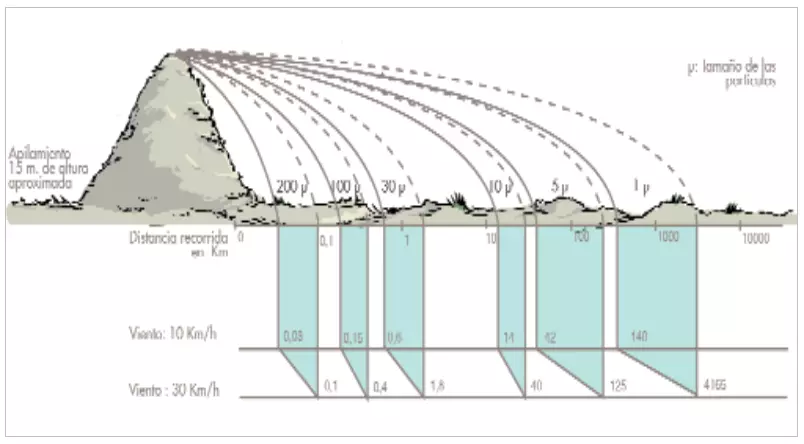How far can the wind carry the dust generated in an aggregate exploitation?

One of the reasons for controlling dust emission in farms is its great capacity to be moved by the wind, thus spreading its harmful effects on health and the environment outside the industrial facilities. Average dust particles (less than 10μm) can take up to one and a half hours to settle, during which time they are at the mercy of the wind. A gentle breeze of 14km/h can send these particles more than 40km from the quarry or mine, a distance that can increase exponentially as the particles get smaller. Fine particles of less than 1.5 μm behave like aerosols, remaining indefinitely in suspension.
| Size | Sedimentation rate | Sedimentatrion time since 15m |
|---|---|---|
| 1000 μm | 395 cm/s | 4 s |
| 100 μm | 29.6 cm/s | 51 s |
| 10 μm | 0.296 cm/s | 1h 25s |
| 1 μm | 0.0035 cm/s | 5 days |
| 0.1 μm | 0.000035 cm/s | 496 days s |
| Size | Laminar wind 10 km/h | Laminar wind 30 km/h |
|---|---|---|
| 1000 μm | 11 m | 33 m |
| 100 μm | 150 m | 430 m |
| 10 μm | 14 km | 42 km |
| 1 μm | 1200 km | 3600 km |
| 0.1 μm | 3 laps of the earth | 9 laps of the earth |
As can be deduced from the graphs, the dust produced in an aggregate operation does not only affect the operation itself, but also goes beyond its limits and where it settles it can reduce the quality of crops such as vines and fruit trees, slowing down the growth of other plants. The dust in suspension can reduce visibility on nearby roads and paths and affect nearby populations with respiratory discomfort.
Among the preventive measures there are 3 main ones, the control of dust sedimentation by humidity, the elimination by aspiration and subsequent separation and the simplest and most economical, the fairing or hooding of the emission points.
Capotex has been offering hooding solutions for all types of conveyor belts for over 20 years. Hooding is a highly efficient passive treatment that will not consume resources or energy. Their installation cost is low, especially compared to other systems, as is their maintenance. A bonnet confines dust from spreading, protects workers from the risk of entrapment or accidents due to falling materials and helps to preserve belts and motors, while preventing product loss.

